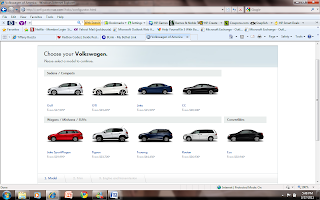When I entered the Volkswagen I was greatly attracted to their initial layout. They had the information that all consumers desire to know upfront (pricing, APR, where to find a dealer) as well as a picture of their featured vehicle. They identify that the customer wants a low price purchase as well as an efficient and marketable vehicle. The website offers links at the bottom of their page to view their carefree maintenance details, their new 2011 vehicle (the Touareg Hybrid) as well as options for upgraded audio systems. One thing that stood out to me was the ‘blog’ link that the website offered. For each model of vehicle VW set up a blog so consumers can post their opinions and feedback from a vehicle allowing prospective consumers to hear from real people who have had experience with the vehicle. Overall, the Volkswagen website was appealing to me.
I have recently seen an increase in the Volkswagens on the road. I saw the Tiguan earlier this year and I had taken an interest in it, so when this MEAN was assigned I decided I would build my own Tiguan. I started by clicking on the “Build and Price” link. I was redirected to site where it asked me what model I want to continue with (see below) and I clicked on the Tiguan. I decided to go with the SE model and the color black. The company definitely catered to my desire to have options. I was able to choose from six different colors for the Tiguan, four different kinds of wheels, two types of interior (leather or cloth), the choice to have a trailer hitch and also gave me the option to add a sunroof. Volkswagen gave me many options to design my vehicle and gave me a detailed summary of what I had just created. When I was finished creating my custom Tiguan I clicked on “Summary” and it gave me full details of what I had just created. It started with the name and model (Tiguan SE) and went into what type of engine (200 hp, 6 speed automatic) and gave me the drive terrain (all wheel drive). The summary also included the base price, how much my added selections were, my destination charge and the overall price. The final detail asked me if I wanted to talk to a dealer and request a test drive of my custom Tiguan.
The website gave me numerous options for different areas of the vehicle. It gave me nine different models to choose from at the start.
When I was finished creating my custom Tinguan I was given a detailed summary of what I had just created. The summary included the price of all the additional ammenities as well as the final price.
I thought the website appealed to my desires for custom features in my vehicle. I liked that it gave you numerous options for every aspect of the vehicle (color, interior, sunroof, etc.) and gave me a detailed summary of what I had created which included the choice to contact a dealer. Overall, the website was greatly appealing and if I could afford a $30,000+ dollar vehicle I would have purchased what I created.
Blessings,
Tiffany














